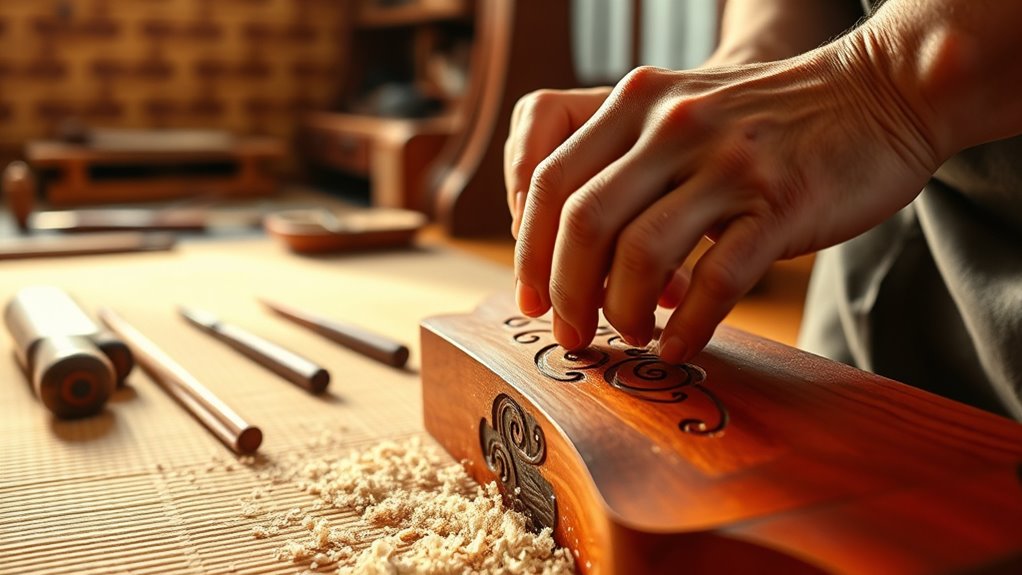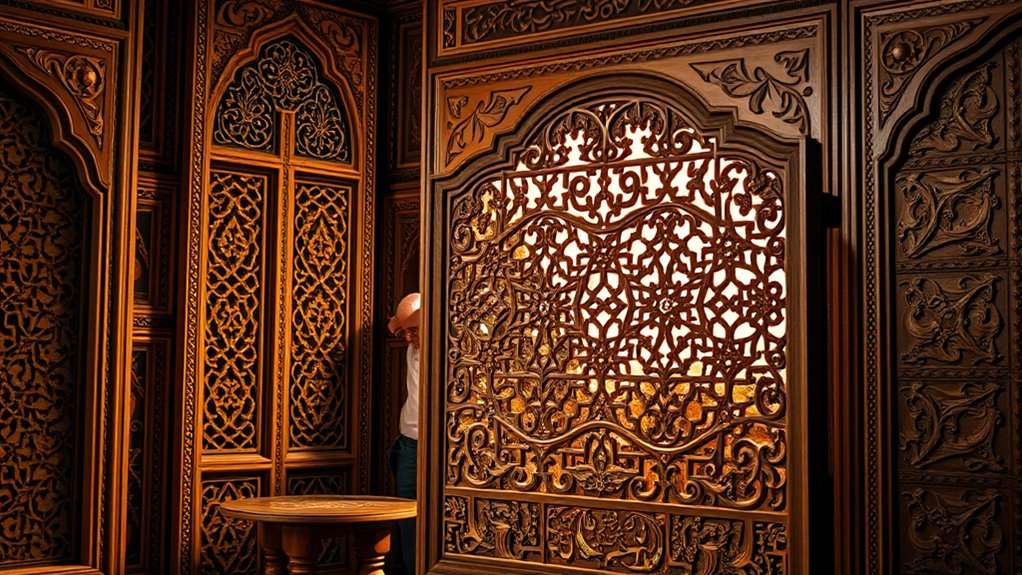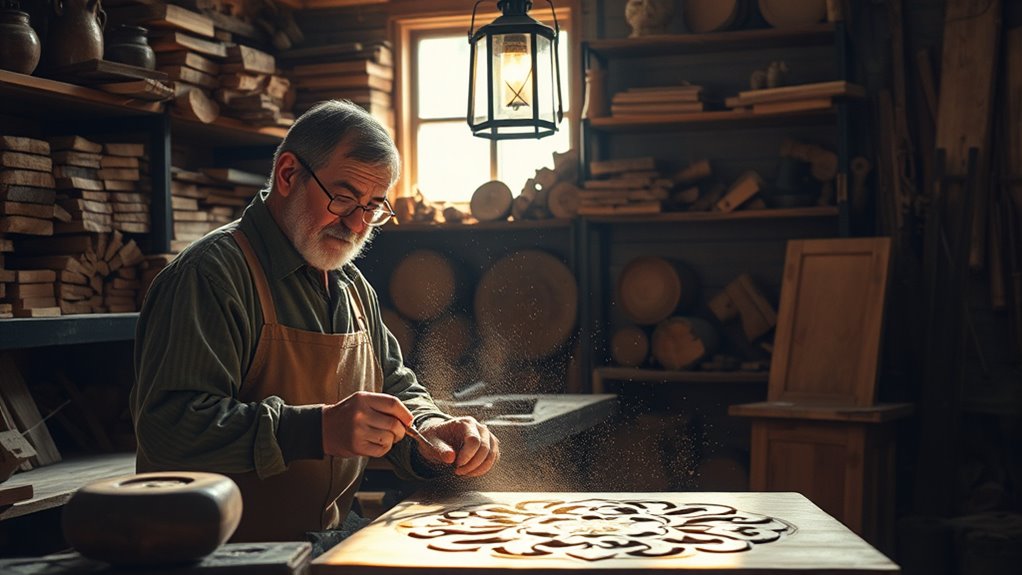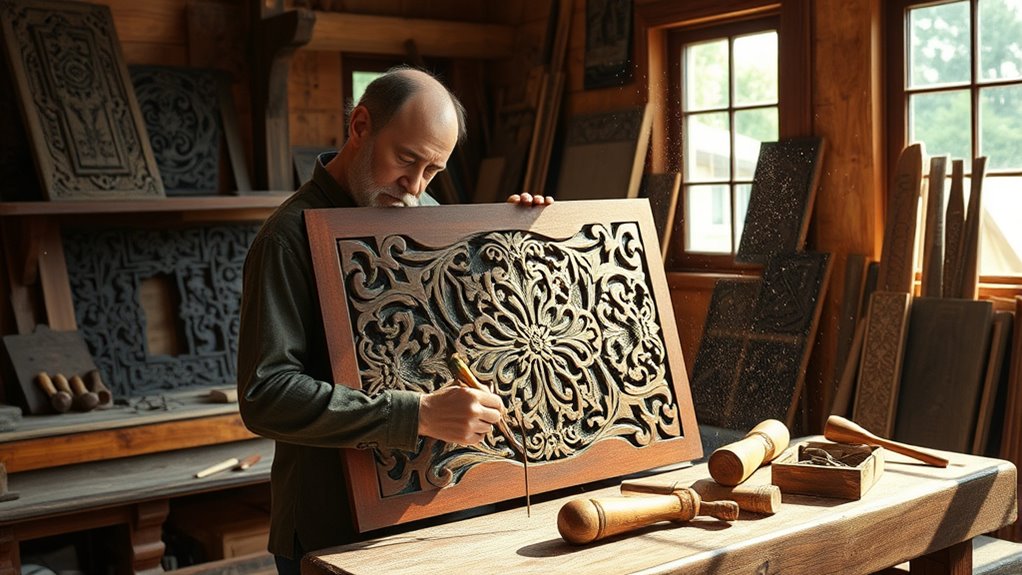Woodworking traditions worldwide showcase a rich mix of techniques, styles, and cultural values. In East Asia, skilled artisans focus on intricate joinery and minimalist design emphasizing harmony and natural beauty. European craftsmen favor durable joints like mortise and tenon, often using hardwoods for strength and elegance. Middle Eastern artisans combine artistry with function through geometric patterns and inlay work. Indigenous practices highlight community traditions, sustainability, and symbolic carvings. Exploring these diverse techniques reveals a deeper appreciation for craftsmanship across cultures.
Key Takeaways
- East Asian craftsmanship emphasizes seamless joinery techniques like tsugime and kanawame, reflecting harmony and natural beauty.
- European woodworking features durable methods such as mortise and tenon, with regional styles like Scandinavian bridle joints.
- Middle Eastern artisans combine artistic marquetry and geometric patterns using traditional inlay techniques like Khatam.
- Indigenous African and American practices utilize local materials and carvings for functional and ceremonial objects.
- Modern efforts focus on preserving traditional techniques through workshops, apprenticeships, and digital knowledge sharing.
East Asian Craftsmanship: Precision and Harmony

East Asian woodworking stands out for its emphasis on precision and harmony, where craftsmanship relies on intricate joinery rather than nails or glue. You’ll notice Japanese carpentry’s mastery of traditional joinery techniques like tsugime and kanawame, which create strong, seamless connections through interlocking joints. These methods showcase precision craftsmanship and a deep respect for wood’s natural qualities, ensuring stability and durability. The minimalist aesthetic extends to shoji screens, where delicate latticework exemplifies harmony and simplicity. East Asian design also embodies wabi-sabi, appreciating imperfection, and incorporates principles of feng shui to promote positive energy flow. Every joint and detail reflects a balance between function and beauty, emphasizing harmony with nature and the environment through skillful craftsmanship. Additionally, these techniques often involve sustainable practices that reduce waste and make the most of natural materials, highlighting their environmental consciousness.
European Joinery and Architectural Heritage

European joinery techniques have evolved over centuries to produce durable, intricate furniture and structural elements that showcase regional craftsmanship. You see this in how mortise and tenon, dovetail, and wedge joints have been refined to create strong, lasting connections in timber. Oak, a favored hardwood, is often used for its strength and beauty, especially in traditional furniture and architectural features. European craftsmanship emphasizes regional variations, like Scandinavian bridle joints and French half-lap joints, reflecting local materials and styles. These methods helped build iconic structures such as medieval timber-framed houses and Renaissance furniture, highlighting a legacy of skill and artistry. Today, European joinery continues to blend tradition with innovation, preserving craftsmanship while adapting to modern architectural needs.
Middle Eastern Artistic and Functional Designs

Have you ever noticed how Middle Eastern woodworking seamlessly combines artistic beauty with practical function? Their use of intricate geometric patterns, marquetry, and inlay techniques like Khatam creates stunning decorative panels and mosque doors. Persian artisans excel in mitering, dovetailing, and butterfly joints, ensuring both durability and elegance in furniture and religious artifacts. Lebanese cedar wood, valued for its strength and fragrance, supports this craftsmanship, symbolizing cultural identity. Islamic design principles emphasize abstract motifs and complex floral patterns, reflecting spiritual symbolism. Artisans rely on traditional craftsmanship, employing hand tools such as saws, chisels, and bow lathes. This combination of skillful techniques and artistic expression results in woodworking that’s both functional and beautifully symbolic, showcasing a rich heritage rooted in meticulous craftsmanship. Additionally, the influence of cultural heritage can be seen in the preservation of traditional motifs and techniques passed down through generations, often reinforced by the use of specialized materials like fine woods and inlay substances.
African and American Indigenous Woodworking Practices

Just as Middle Eastern artisans blend artistry with function, indigenous African and American woodworking practices showcase a deep connection to culture and environment. Indigenous woodworking in Africa uses local materials like palm, teak, and mahogany, employing African techniques such as traditional joinery, including lap and dowel joints, and woven structures. These methods support regional architecture, like roundhouses and mudbrick buildings, emphasizing functional craftsmanship. Across the Americas, American craftsmanship combines local woods with European influences, creating carved objects, ceremonial items, and furniture. Native American artisans excel in carving, inlay, and gilding, producing masks, totem poles, and ritualistic objects rich in cultural symbolism. Both regions prioritize community practices, preserving their cultural identity through functional, symbolic, and community-centered woodworking traditions. Developing Cultural Intelligence can further enhance understanding and appreciation of these diverse craftsmanship traditions. Additionally, these practices often involve sustainable resource use, ensuring the preservation of natural environments that support their cultural heritage. Recognizing the importance of traditional techniques helps maintain the authenticity and longevity of these cultural expressions. Furthermore, innovative design continues to influence modern adaptations of these traditional crafts, bridging the past with contemporary practices.
Modern Revival and Preservation of Traditional Techniques

Across the globe, communities are actively working to revive and preserve traditional techniques through workshops, apprenticeships, and cultural preservation programs. These efforts help safeguard woodworking heritage and historic craftsmanship by documenting indigenous tools and craftsmanship methods, such as Japanese joinery or Chinese plane-making. Modern artisans incorporate traditional joinery, carving, and finishing techniques into contemporary furniture design, ensuring artisanal skills stay alive. Preservation programs often utilize digital media and online tutorials to reach wider audiences, spreading awareness across generations. Digital media and online tutorials are increasingly employed to disseminate craftsmanship knowledge more broadly. Apprenticeships provide hands-on experience, fostering a deeper understanding of craftsmanship methods. Additionally, the integration of AI security technologies in these preservation efforts helps protect digital archives and sensitive information related to traditional knowledge. Developing a comprehensive cultural heritage strategy ensures that these skills are not only preserved but also appreciated in modern contexts. Incorporating community engagement initiatives further encourages cultural pride and intergenerational knowledge transfer, vital for sustaining these ancient skills.
Frequently Asked Questions
Where Is Woodworking Most Popular?
You might think woodworking is most popular in specific regions, but it’s truly widespread worldwide. You see vibrant scenes in East Asia, especially Japan and China, where traditional joinery and marquetry thrive. Europe boasts centuries of craftsmanship in furniture and regional styles. Meanwhile, Middle Eastern artisans craft intricate geometric inlays, and indigenous communities preserve unique techniques. No matter where you are, woodworking remains a universal craft that connects cultures through skill and creativity.
Where Did Woodworking Originate?
Imagine carving your story into history’s oldest tree—woodworking originated in ancient Egypt over 5,000 years ago. You’re working with primitive tools like adzes and chisels, shaping materials from stone, bronze, and iron. Early civilizations, especially in the Middle East and East Asia, perfected techniques like joinery and inlay work. You’re standing on a foundation built by those ancient artisans, whose innovations still influence your craft today.
What Is the Old Name for a Woodworker?
The old name for a woodworker is “carpenter,” which comes from the Latin “carpentarius,” meaning wagon maker. You might also hear terms like “joiner” for those focusing on precise joints or “cabinetmaker” for furniture specialists. In medieval Europe, they were called “stainers” or “turners,” depending on their craft. These names highlight the different skills and roles craftsmen held in woodworking history.
What Is the Difference Between a Woodworker and a Carpenter?
You’re wondering about the difference between a woodworker and a carpenter. A carpenter mainly constructs and repairs structures like buildings, working on-site with large tools and rough materials. In contrast, a woodworker focuses on creating detailed, finished items such as furniture, often working in a workshop with fine veneers and intricate joinery. While their skills overlap sometimes, carpenters handle structural tasks, and woodworkers emphasize craftsmanship and ornamentation.
Conclusion
By exploring these diverse woodworking traditions, you’ll see how each culture’s unique techniques and values shape their artistry. You might think these skills are outdated, but imagine the intricate carvings and sturdy structures still standing today—proof that craftsmanship endures. Embracing these traditions not only preserves history but also inspires your own creativity. So, next time you pick up a tool, remember you’re part of a global legacy of skilled artisans.









